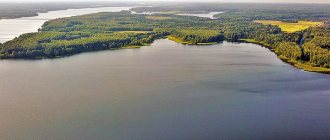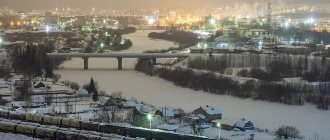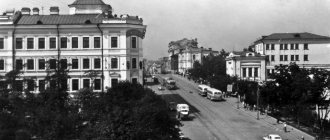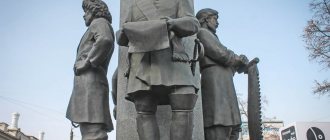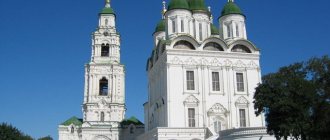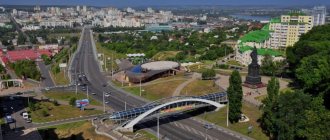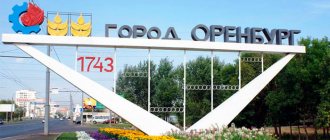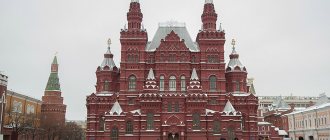So, a trip to Konstantinovo. I immediately apologize for the quality of the photos. I'm not a photographer, and my equipment is purely amateur. I just wanted to share my impressions. Early Sunday morning on June 16th of this year, 2013, we left home. We got to Ryazan in a breeze on a comfortable bus from Vykhino in less than 3 hours. We stayed at the Priokskaya Hotel. While we were riding on the bus to the hotel, the residents of Ryazan gave us advice on where to see things - what nice people! Grandfather talked about the underground passage on the territory of the Kremlin, remembered the times when boats flew to Konstantinovo, an aunt immediately joined in and talked about the airborne school, another aunt promised to indicate the right stop - in general, Ryazan welcomed us with open arms. We dropped off our things at the hotel and immediately headed to Sergei Alexandrovich’s native village. It turned out that getting to it from Ryazan is much more difficult than from Moscow to Ryazan. Buses go there only in the morning and in the evening - we, accordingly, did not have time for the before lunch, and it was not our plan to wait for the evening one. We decided to go to Rybnoye, from there it’s another 20 km to the village, but we thought maybe it would be easier with transport there. But no! While we were traveling in the bus, another kind Ryazan resident suggested that there are no buses from Rybnoye to Konstantinovo, and it would be better for us to get off “at the cross”, and there it is 5 km, and here it is - the gentle homeland. There is hope of catching a ride. We leave “at the cross.” “Hitchhikers” there rush at a minimum of 120 km/h and do not think about taking fellow travelers. We are doomed to walk 5 km. But nothing can stop true fans. And what a beauty! The road is in an open field, and there are no houses on the horizon. “Only blue sucks eyes” We wandered and wandered, having lost faith in kind-hearted car enthusiasts, resigning ourselves to the lot of meek travelers, and finally arrived.
We were greeted by a village with domestic cattle grazing wildly.
And here it is! Favorite region! The heart dreams of stacks of sun in the waters of the bosom. I would like to get lost in the greenery of your hundred-bellied greens. Along the border, on the edge, there is mignonette and a riza of porridge. And the meek nuns call Willow to the rosary. The swamp smokes like a cloud, Burnt smoke in the heavenly rocker. With a quiet secret for someone I hid thoughts in my heart. I meet everything, I accept everything, I am glad and happy to take out my soul. I came to this earth to leave it quickly.
Behind the mountains, behind the yellow valleys, a trail of villages stretches. I see a forest and an evening fire, And a hedge entwined with nettles. There, in the morning, over the church domes, the heavenly sand turns blue, and the roadside grasses ring from the lakes with a watery breeze. It is not for the songs of spring over the plain that the green expanse is dear to me - I fell in love with the melancholy of a crane On a high mountain a monastery. Every evening, as the blue clouds over, as the dawn hangs on the bridge, you go, my poor wanderer, to bow to love and the cross. The meek spirit of a monastery resident, You eagerly listen to the litany, Pray before the face of the Savior for my lost soul.
The terrain there is hilly, waist-deep grass. The hike along the Oka River was a good addition to our 5-kilometer run. Plus, the weather had cleared up, the sun was baking the tops of our heads, and the midges, which were there in abundance, were terribly happy about our appearance. But this is such nonsense compared to what we are lucky enough to breathe deeply and absorb with our eyes
life and death…
This street is familiar to me, And this low house is familiar. The wires of blue straw fell over the window. There were years of severe disasters, Years of violent, insane forces. I remembered my village childhood, I remembered the village blue. I did not seek either glory or peace, I am familiar with the vanity of this glory. And now, when I close my eyes, I see only my parents’ house. I see a garden dotted with blue, August quietly lay down against the fence. The linden trees are held in their green paws. Bird noise and chirping. I loved this wooden house, A menacing wrinkle glowed in the logs, Our stove howled somehow wildly and strangely on a rainy night. The voice is loud and sobbing, like talking about someone dead, alive. What did he see, a brick camel, in the howling of the rain? Apparently, he saw distant countries, The dream of another and blooming time, The golden sands of Afghanistan And the glass gloom of Bukhara. Oh, and I know these countries - I myself have walked a long way there. Only closer to my native land I would like to turn now. But that gentle slumber faded away, Everything decayed in blue smoke. Peace be with you - the straw of the field, Peace be with you - a wooden house!
View from the Yeseninsky yard
Sergun planted poplar
Neighbors of the Yesenins (residential house)
Zemstvo primary school, where little Seryozhka studied
The Kashins' estate
Well, the village, of course, is far from being in the form in which Sergun loved it: ideal lawns, tiled paths, restored buildings, exhibits covered with yellow ribbons - a tourist complex. Yesenin is alive on the banks of the Oka, in the present village his presence is faintly felt. After dinner at a restaurant around 8 pm, we set off for Ryazan. The last bus leaves from Konstantinovo to Ryazan at 20:00. We hoped that it would not be cancelled, however, when a taxi kindly stopped in front of us, offering to take us to the hotel entrance for 700 re, we could not refuse, remembering our heroic forced march. Moreover, the price for 40 km is frankly trivial. Crushed in room a bottle of cognac for the blessed memory of our Sergei Alexandrovich, we fell asleep closer to midnight. I slept great! The air of Ryazan is, indeed, somehow healing. We had breakfast and went for a walk around the city. On the morning of June 17 it’s +28, the sun is blazing hot! territory of the Ryazan Kremlin:
A little bit of Ryazan
Tame birds
and foot
get in line, you sons of bitches, get in line!
On June 17 at about 9 pm we are already in Pushkino. Wow, it turns out it’s so cold and rainy here!
Pushkino: what cannon is the city named after and how did it help the forests that burned in the summer of 2010
We continue the series “Small Towns of Russia” and today we will go to Pushkino, Moscow region.
This is the center of Russian forest science. 7 large enterprises of the city are associated with forestry. Tons of seeds of valuable coniferous species are stored there. It was from there that seeds were taken to restore forests near Moscow after the fires of 2010. Also in the city, local history buffs are engaged in the reconstruction of tanks. Moscow is surrounded by literary cities. In the southern direction - Chekhov, in the northern direction - Pushkino. True, unlike Pushkin of St. Petersburg, the city near Moscow is named not in honor of the great poet, but in honor of his ancestor, boyar Grigory Morkhinin. These lands belonged to him in the 14th century, and his nickname was Cannon because of his loud voice and strength. This is where the name of the city came from. The monument to the vociferous boyar stands right at the entrance, but a separate sculpture was not dedicated to his famous descendant.
In the city center on Sovetskaya Square, Pushkin sits next to Krylov. There are no more monuments to the poet in the city. But the central Pushkin streets were named after other writers. The first rehearsals of Chekhov’s “The Seagull” took place here, and Prishvin, Paustovsky and Mayakovsky vacationed at their summer dachas. Today, the literary glory of the town near Moscow is not often remembered. For 80 years, Pushkino has been known as the center of Russian forest science.
“Where we see red dots, it means things are bad there. Where there are green ones, things are relatively normal. Where there are yellow ones, you need to pay attention. Those. This is the effect of a traffic light throughout the Russian Federation,” says Vladimir Soldatov, director of the FBU Roslesozashchita.
The Russian Forest Protection Center is engaged in so-called forest prevention. Throughout the country, the condition of trees is monitored, pest infestations are predicted, and the likelihood of fires is assessed. The data is sent to the central office in Pushkin, and from here recommendations are sent to regional authorities on what measures to take to save the forest.
“This, in my opinion, is one of the most important laboratories, the laboratory of phytopathology. Phytopathology is the science of fungal diseases. Just imagine how many mushrooms there are, a sprout comes out and then the mushrooms attack it. Therefore, we give recommendations on how to cope with this or that mushroom,” explains Vladimir Soldatov.
In case the forests cannot be saved, gold reserves are kept in the center. 12 tons of seeds of especially valuable conifers are kept at a temperature of -18 degrees and used only in emergency situations. From here they took seeds to restore forests near Moscow after the fires of 2010.
Despite his love for scary machines, Pavel also sees the meaning of life in preserving the forest. On this amphibian he set a world record - in 23 days he and his friends traveled from Pushkino to the Kola Peninsula. The newfound popularity is used for a good cause - it helps to carry out environmental campaigns.
“Somehow I want to push the ideas of creation into the world, but until you are noticed, the ideas of creation will not be pushed, so we will become famous, recognizable and we will push good ideas into life,” says Pavel Zavgorodniy, extreme sportsman.
This armored car took part in parades on Red Square in the 80s, and three months ago, under the leadership of Pavel, it sailed across the Barents Sea and the Arctic Ocean. It turned out that the car is no less suitable for travel than for military operations. During the entire trip to the Kola Peninsula, the amphibian, unlike other SUVs in the team, never failed. In water, the car reaches speeds of up to 10 km per hour. For this, everything is provided here: an echo sounder for determining the depth, a navigator and a radio with a marine range.
“Sleeping in this car is a real thing, I lived all 23 days in it, I have a small bed in the back, which is very comfortable for me to sleep on,” says Pavel Zavgorodniy. Sergei does not drive military equipment, he restores it. Together with his assistants, he assembles tanks from a pile of scrap metal. Over the course of 8 years, he restored 10 cars.
“This is part of our new tank, we will have a 34. Released in 1942. Here is the tower in 1942, Nizhny Novgorod. This will be such an interesting exhibit, because there is a 76 mm cannon,” says Sergei Chibineev, a collector, “But this, too, was originally a pile of metal. Yes, these were the pieces that were put in order. You can even see the welded seams, how it was assembled.”
Sergei collects not only tanks, but also military items, posters and portraits. He opened a whole museum on his site. The hobby began in childhood: at first he collected toy soldiers, now he collects the national uniforms of the countries that participated in the Second World War. You won’t see such uniforms of a Hungarian soldier in every Russian museum.
“Probably, there are three categories of people: someone lives in the future, someone in the present. And I am one of those who remained somewhere in the past. Everything is connected with this,” shares Sergei Chibineev.
Sergei is the exception rather than the rule.
In Pushkino people do not live in the past. Young families come here to build a future. The apartments are cheaper than in Moscow, it’s not far from the capital - all the work is there. Due to active development, almost nothing remains of the corner that Prishvin and Mayakovsky loved. But few people care about this. The new life dictates its own laws, and looking back is not accepted. The artist Evgeny Kamzolkin lived on Pisarevskaya Street in Pushkino. In 1918, he created the “Hammer and Sickle” emblem, one of the main and world-famous state symbols of the Soviet Union.
Toponymy
In the Moscow region there is the city of Pushkino, the name of which is perceived by almost everyone as perpetuating the name of the great Russian poet A.S. Pushkin. But this is not entirely true, or rather, not at all true. A. S. Pushkin on his father’s side comes from a very ancient and noble family, the first mention of which dates back to the 13th century. The famous historian S. B. Veselovsky, on the basis of reliable documents, restores the Pushkin family from the 13th century. Its first reliable representative was Ratsha (or Racha). This is probably the Novgorod form of the name (in -sha) Ratibor or Ratislav, Ratmir, like Kirsha from Kirill, Pavsha from Pavel. Ratsha lived in Novgorod and was an associate of Prince Alexander Nevsky. A.S. Pushkin knew about this and wrote in “My Genealogy”: My ancestor Racha served Saint Nevsky with mortal muscle. A descendant of Ratsha, Gavrila Aleksic, was also an associate of Alexander Nevsky. This was the prince’s adviser, a senior warrior, his comrade in arms. After the death of Alexander Nevsky in 1263, the sons of Gavrila Aleksich continued to serve the sons of Alexander Nevsky. Gavrila Aleksich had a son, Ivan, nicknamed Morkhinya. The son of Ivan Morkhini, Alexander Ivanovich Morkhinin, and his five sons went to Moscow to serve the Moscow prince. One of them, Grigory Morkhinin, received the nickname Pushka in Moscow, from which the surname Pushkin came. The descendants of Gregory Pushka had large plots of land with villages and villages in the Moscow region. One of the possessions of Grigory Pushka was the village of Pushkino on the Ucha River not far from Moscow, which was named after its first owner, Pushka. Subsequently, the village turned into the city of Pushkin. In documents of the 15th century, almost 400 years before the birth of the poet, the village was already mentioned under the name Pushkino. S. B. Veselovsky suggests that the numerous Pushkin family, descendants of Grigory Pushka, in the 16th-17th centuries. belonged to many villages with the name Pushkino, as well as Pushkino-Andrianovskoye, the village of Ulitino, the villages of Tovarkovo, Rozhnovo, Musina. The last village belonged to Mikhail Musa, from whom the Musin-Pushkin family descended. And one of the representatives of this family, Count A.I. Musin-Pushkin, a famous Russian historian of the late 18th - early 19th centuries, found a copy of the manuscript “The Tale of Igor’s Campaign” in the monastery archives in Yaroslavl. In 1718, the great-grandfather of A.S. Pushkin is mentioned - Alexander Petrovich and his son Lev Alexandrovich, Pushkin’s grandfather. My grandfather was an artillery corporal, fell out of favor under Catherine II and was even imprisoned for a year for taking his side rather than the side of Catherine II during the overthrow of Peter III. Pushkin wrote about this:
My grandfather, when the rebellion arose
In the middle of the Peterhof courtyard,
Like Minich, he remained faithful
The Fall of the Third Peter.
The Orlovs were honored then,
And my grandfather is in the fortress, in quarantine.
Since the surname Pushkin is based on the nickname Pushka, it is interesting to know what it meant, and therefore what the surname Pushkin means. As you know, most often nicknames were and are given based on some of the most noticeable character traits, appearance, position, or origin of a person. It is unknown how Grigory Aleksandrovich - Cannon - got his nickname. The most common hypothesis suggests that the nickname Cannon is based on the word cannon in the meaning of a well-known firearm. But how “the character and appearance of Grigory Alexandrovich is connected with a gun is unknown, and therefore modern science is inclined to reject
early hypothesis. New ways of researching surnames are needed, and we will try to analyze one of them. To do this, we will involve in the analysis known facts that were not previously taken into account. Moreover, we can directly say that the study of the origin of the Pushkin surname has not yet begun.
In ancient times, Russians did not have surnames, but nicknames, which later became surnames, like the above-mentioned Morkhinya - Morkhinin.
Cannon - Pushkin. According to tradition, surnames for a long time were also called family character. This means that members of one family or clan could be nicknamed by birds, members of another clan or family - by fish, etc. Nicknames could also be given according to the characteristics of the members of the clan or family themselves: appearance, character traits, mental abilities and many others signs. For example, there are known “fish” nicknames that were borne by members of the same family: Lin, Linev, Okun Ivanovich Linev (from him came the Okunevs), Andrei Ivanovich Som (from him came the Somovs), Alexey Ershov son Linev, etc. According to S. B. Veselovsky, in the family of the Smolensk princes Fomin in the 15th century. there have been “grass” nicknames for four generations: Grass (from which came the Grass), Sedge, Wheatgrass, Sorrel, Woodpecker (i.e. clover), Elm (field pea). And one of them bore the nickname Branch, and his son was called Vetka Branch.
Nicknames were widely used in numerous branches of the family of Gregory Pushka, among his relatives, including family ones. Among the Osteevs were Vasily Chulok and his son Ivan Vasilyevich Chebot. Fyodor Tovarkov had one son, Ivan Fedorovich Us Tovarkov, and the other, Boris Fedorovich Shushlepa (shushlepa - “lazy, lazy”). Among the Pushkins there were the following nicknames: Dykhailo, Zhuleba, Maloy, Molodoy, Lame, etc., given mainly by the character and appearance of these descendants of Grigory Pushka.
Grigory Alexandrovich had the nickname Pushka, and his grandfather Ivan had the nickname Morkhinya, which passed to his son Alexander in the form of the surname Morkhinin. It seems somewhat strange that the son of Alexander Morkhinin, Grigory, having moved to Moscow, loses this surname (nickname) and receives a new one - Pushka. Is it new? It is likely that both of these nicknames - Morkhinya and Pushka - were the same and meant the same thing, for example, some character trait or feature of appearance. They (the traits) were called by different words, one in Novgorod with the word morkh, and the other in Moscow with the word cannon. We do not have exact evidence that morkh was a Novgorod word, and gun was a Moscow word. After all, we are talking about a time separated from us by several centuries.
In the word morkhinya, it is necessary to exclude the suffix -in and the ending -ya, which form the word morkh into a nickname. As dialect dictionaries of the Russian language show, the words morkh (and its derivatives) and gun have many common meanings. One can say more - they have a common basic meaning, from which others, close ones, have developed. The words morkh and fluff mean everything soft, light, that moves or flutters in the wind: fluff, fur, including its small pieces, tassels, fringe (as decoration). Dahl cites the word guns (without accent) to mean “Mordovian earrings, pendants made of down or squirrel fur.” Moreover, the word morkh more often than cannon denotes fraying scraps of worn-out clothing or even scraps of material. And the word cannon is mostly pieces of fur and fluff. But both words mean something that vibrates, moves, flutters due to the movement of air, wind; that which is not fixed is mobile.
On this basis, it can be assumed that the nicknames Morkhinya and Pushka are based on the fact that these people had some characteristic feature of appearance associated with fringe, tassels, rags, flaps in clothes or with the peculiarity of the hair on their heads.
But a more convincing basis for the nickname Morkhin, which later turned into Pushka, seems to be the figurative meaning of the word morkh - “a weak-willed person.” This meaning is now known in the folk dialects of the Middle Urals. Indeed, such a figurative meaning may have developed for the word morkh; fringe, rags, rags - everything that is unstable, fluctuates in the wind, moves from a slight movement of the wind, and hence the meaning “a person of unstable, unsteady character, who fluctuates in his decisions and actions under the influence of various circumstances.” We have no evidence that Ivan Morkhinya, the son of Gavrila Aleksich, an associate of Alexander Nevsky, had exactly this character. But it can be assumed that if such a courageous and wise man as Gavrila Aleksich had a weak-willed son, then this circumstance - a sharply opposite trait of his character - became the basis for the nickname Morkhin. We do not know such a character trait in Grigory Alexandrovich Pushka. Perhaps he did not have the same character or appearance features as his grandfather Ivan Morkhinya. He could have received his nickname from his grandfather “by inheritance”, according to tradition, as a family one, but in the Moscow way - with the word morkh replaced by cannon.
Our assumption is based only on the data of the language, and not on real reality (it is unknown to us), but the language reflects it. The search can continue.
| < Previous | Next > |


